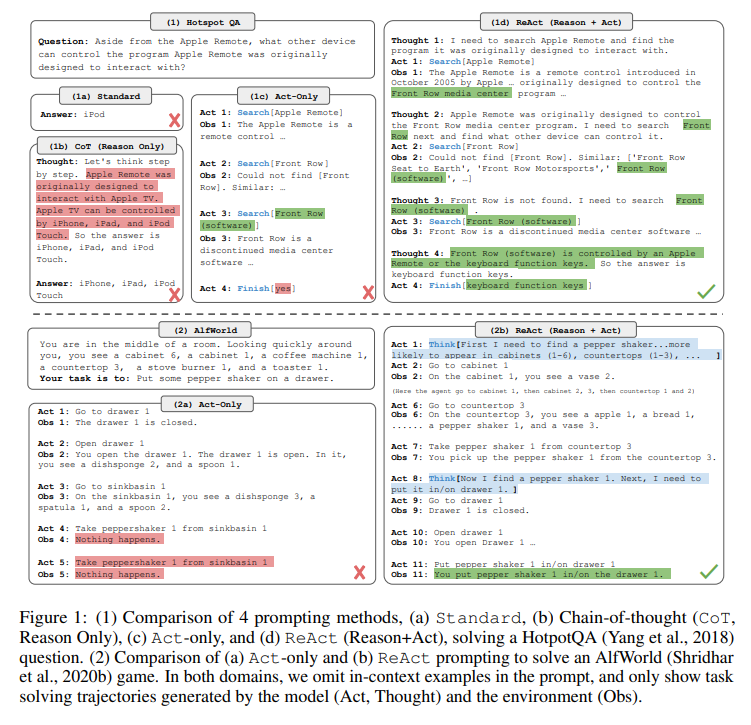Early large language models (LLMs) excelled at generating coherent text; however, they struggled with tasks that required precise operations, such as arithmetic calculations or real-time data lookups. The emergence of tool-augmented agents has bridged this gap by endowing LLMs with the ability to invoke external APIs and services, effectively combining the breadth of language understanding with the specificity of dedicated tools. Pioneering this paradigm, Toolformer demonstrated that language models can teach themselves to interact with calculators, search engines, and QA systems in a self-supervised manner, dramatically improving performance on downstream tasks without sacrificing their core generative abilities. Equally transformative, the ReAct framework interleaves chain-of-thought reasoning with explicit actions, such as querying a Wikipedia API, allowing agents to iteratively refine their understanding and solutions in an interpretable, trust-enhancing manner.
Core Capabilities
At the center of actionable AI agents lies the capability for language-driven invocation of tools and services. Toolformer, for instance, integrates multiple tools by learning when to call each API, what arguments to supply, and how to incorporate results back into the language generation process, all through a lightweight self-supervision loop that requires only a handful of demonstrations. Beyond tool selection, unified reasoning-and-acting paradigms like ReAct generate explicit reasoning traces alongside action commands, enabling the model to plan, detect exceptions, and correct its trajectory in real-time, which has yielded significant gains in question answering and interactive decision-making benchmarks. In parallel, platforms such as HuggingGPT orchestrate a suite of specialized models, spanning vision, language, and code execution, to decompose complex tasks into modular subtasks, thereby extending the agent’s functional repertoire and paving the way toward more comprehensive autonomous systems.
Memory and Self-Reflection
As agents undertake multi-step workflows in rich environments, sustained performance demands mechanisms for memory and self-improvement. The Reflexion framework reframes reinforcement learning in natural language by having agents verbally reflect on feedback signals and store self-commentaries in an episodic buffer. This introspective process strengthens subsequent decision-making without modifying model weights, effectively creating a persisting memory of past successes and failures that can be revisited and refined over time. Complementary memory modules, as seen in emerging agent toolkits, distinguish between short-term context windows, used for immediate reasoning, and long-term stores that capture user preferences, domain facts, or historical action trajectories, enabling agents to personalize interactions and maintain coherence across sessions.
Multi-Agent Collaboration
While single-agent architectures have unlocked remarkable capabilities, complex real-world problems often benefit from specialization and parallelism. The CAMEL framework exemplifies this trend by creating communicative sub-agents that autonomously coordinate to solve tasks, sharing “cognitive” processes and adapting to each other’s insights to achieve scalable cooperation. Designed to support systems with potentially millions of agents, CAMEL employs structured dialogues and verifiable reward signals to evolve emergent collaboration patterns that mirror human team dynamics. This multi-agent philosophy extends to systems like AutoGPT and BabyAGI, which spawn planner, researcher, and executor agents. Still, CAMEL’s emphasis on explicit inter-agent protocols and data-driven evolution marks a significant step toward robust, self-organizing AI collectives.
Evaluation and Benchmarks
Rigorous evaluation of actionable agents necessitates interactive environments that simulate real-world complexity and require sequential decision-making. ALFWorld aligns abstract text-based environments with visually grounded simulations, enabling agents to translate high-level instructions into concrete actions and demonstrating superior generalization when trained in both modalities. Similarly, OpenAI’s Computer-Using Agent and its companion suite utilize benchmarks like WebArena to evaluate an AI’s ability to navigate web pages, complete forms, and respond to unexpected interface variations within safety constraints. These platforms provide quantifiable metrics, such as task success rates, latency, and error types, that guide iterative improvements and foster transparent comparisons across competing agent designs.
Safety, Alignment, and Ethics
As agents gain autonomy, ensuring safe and aligned behavior becomes paramount. Guardrails are implemented at both the model architecture level, by constraining permissible tool calls, and through human-in-the-loop oversight, as exemplified by research previews like OpenAI’s Operator, which restricts browsing capabilities to Pro users under monitored conditions to prevent misuse. Adversarial testing frameworks, often built on interactive benchmarks, probe vulnerabilities by presenting agents with malformed inputs or conflicting objectives, allowing developers to harden policies against hallucinations, unauthorized data exfiltration, or unethical action sequences. Ethical considerations extend beyond technical safeguards to include transparent logging, user consent flows, and rigorous bias audits that examine the downstream impact of agent decisions.
In conclusion, the trajectory from passive language models to proactive, tool-augmented agents represents one of the most significant evolutions in AI over the past years. By endowing LLMs with self-supervised tool invocation, synergistic reasoning-acting paradigms, reflective memory loops, and scalable multi-agent cooperation, researchers are crafting systems that not only generate text but also perceive, plan, and act with increasing autonomy. Pioneering efforts such as Toolformer and ReAct have laid the groundwork, while benchmarks like ALFWorld and WebArena provide the crucible for measuring progress. As safety frameworks mature and architectures evolve toward continuous learning, the next generation of AI agents promises to integrate seamlessly into real-world workflows, delivering on the long-promised vision of intelligent assistants that truly bridge language and action.
Sources:
- https://arxiv.org/abs/2302.04761
- https://arxiv.org/abs/2210.03629
- https://arxiv.org/abs/2303.11366
- https://arxiv.org/abs/2303.17760
- https://arxiv.org/abs/2010.03768
- https://arxiv.org/abs/2305.16291
The post From Text to Action: How Tool-Augmented AI Agents Are Redefining Language Models with Reasoning, Memory, and Autonomy appeared first on MarkTechPost.
Source: Read MoreÂ


